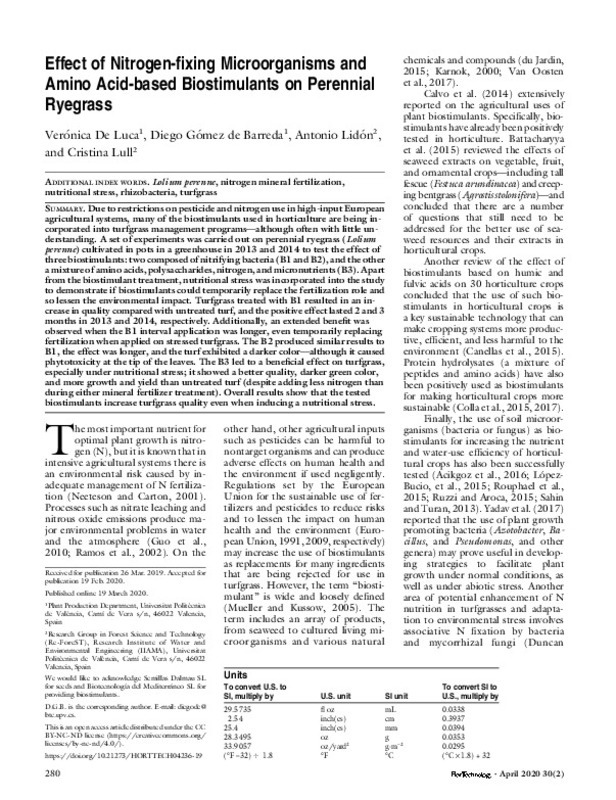JavaScript is disabled for your browser. Some features of this site may not work without it.
Buscar en RiuNet
Listar
Mi cuenta
Estadísticas
Ayuda RiuNet
Admin. UPV
Effect of Nitrogen-fixing Microorganisms and Amino Acid-based Biostimulants on Perennial Ryegrass
Mostrar el registro sencillo del ítem
Ficheros en el ítem
| dc.contributor.author | De Luca, Verónica
|
es_ES |
| dc.contributor.author | Gómez De Barreda, Diego
|
es_ES |
| dc.contributor.author | Lidón, Antonio
|
es_ES |
| dc.contributor.author | Lull Noguera, Cristina
|
es_ES |
| dc.date.accessioned | 2021-03-05T04:32:28Z | |
| dc.date.available | 2021-03-05T04:32:28Z | |
| dc.date.issued | 2020-04 | es_ES |
| dc.identifier.issn | 1063-0198 | es_ES |
| dc.identifier.uri | http://hdl.handle.net/10251/163189 | |
| dc.description.abstract | [EN] Due to restrictions on pesticide and nitrogen use in high-input European agricultural systems, many of the biostimulants used in horticulture are being incorporated into turfgrass management programs-although often with little understanding. A set of experiments was carried out on perennial ryegrass (Lolium perenne) cultivated in pots in a greenhouse in 2013 and 2014 to test the effect of three biostimulants: two composed of nitrifying bacteria (B1 and B2), and the other a mixture of amino acids, polysaccharides, nitrogen, and micronutrients (B3). Apart from the biostimulant treatment, nutritional stress was incorporated into the study to demonstrate if biostimulants could temporarily replace the fertilization role and so lessen the environmental impact. Turfgrass treated with B1 resulted in an increase in quality compared with untreated turf, and the positive effect lasted 2 and 3 months in 2013 and 2014, respectively. Additionally, an extended benefit was observed when the B1 interval application was longer, even temporarily replacing fertilization when applied on stressed turfgrass. The B2 produced similar results to B1, the effect was longer, and the turf exhibited a darker color-although it caused phytotoxicity at the tip of the leaves. The B3 led to a beneficial effect on turfgrass, especially under nutritional stress; it showed a better quality, darker green color, and more growth and yield than untreated turf (despite adding less nitrogen than during either mineral fertilizer treatment). Overall results show that the tested biostimulants increase turfgrass quality even when inducing a nutritional stress. | es_ES |
| dc.language | Inglés | es_ES |
| dc.publisher | American Society for Horticultural Science | es_ES |
| dc.relation.ispartof | HortTechnology | es_ES |
| dc.rights | Reconocimiento - No comercial - Sin obra derivada (by-nc-nd) | es_ES |
| dc.subject | Lolium perenne | es_ES |
| dc.subject | Nitrogen mineral fertilization | es_ES |
| dc.subject | Nutritional stress | es_ES |
| dc.subject | Rhizobacteria | es_ES |
| dc.subject | Turfgrass | es_ES |
| dc.subject.classification | EDAFOLOGIA Y QUIMICA AGRICOLA | es_ES |
| dc.subject.classification | PRODUCCION VEGETAL | es_ES |
| dc.title | Effect of Nitrogen-fixing Microorganisms and Amino Acid-based Biostimulants on Perennial Ryegrass | es_ES |
| dc.type | Artículo | es_ES |
| dc.identifier.doi | 10.21273/HORTTECH04236-19 | es_ES |
| dc.rights.accessRights | Abierto | es_ES |
| dc.contributor.affiliation | Universitat Politècnica de València. Departamento de Producción Vegetal - Departament de Producció Vegetal | es_ES |
| dc.contributor.affiliation | Universitat Politècnica de València. Departamento de Química - Departament de Química | es_ES |
| dc.description.bibliographicCitation | De Luca, V.; Gómez De Barreda, D.; Lidón, A.; Lull Noguera, C. (2020). Effect of Nitrogen-fixing Microorganisms and Amino Acid-based Biostimulants on Perennial Ryegrass. HortTechnology. 30(2):280-291. https://doi.org/10.21273/HORTTECH04236-19 | es_ES |
| dc.description.accrualMethod | S | es_ES |
| dc.relation.publisherversion | https://doi.org/10.21273/HORTTECH04236-19 | es_ES |
| dc.description.upvformatpinicio | 280 | es_ES |
| dc.description.upvformatpfin | 291 | es_ES |
| dc.type.version | info:eu-repo/semantics/publishedVersion | es_ES |
| dc.description.volume | 30 | es_ES |
| dc.description.issue | 2 | es_ES |
| dc.relation.pasarela | S\407568 | es_ES |
| dc.subject.ods | 15.- Proteger, restaurar y promover la utilización sostenible de los ecosistemas terrestres, gestionar de manera sostenible los bosques, combatir la desertificación y detener y revertir la degradación de la tierra, y frenar la pérdida de diversidad biológica | es_ES |








